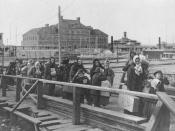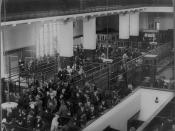Amazing changes took place in the United States between the first federal census in 1790 and the eleventh in 1890. At the end of the eighteenth century, the United States was a struggling nation composed of mutually wary political communities stretched along the Atlantic seaboard. Transportation and communication were primitive, and the American economy revolved around agriculture and the simple commercial networks that got farm products to market. More than 90 percent of the citizens lived in the countryside, and the nation's largest city, Philadelphia, had only 42,444 inhabitants. By the final decade of the nineteenth century, the United States stretched from the Atlantic to the Pacific and constituted the leading industrial nation on earth. Train rails and telegraph wires bound together the farthest points of the continent. New York, the largest city, had 1,515,301 residents on Manhattan Island; fifteen other cities had surpassed the 200,000 mark; and about 23.3
percent of the population lived in communities with more than 25,000 inhabitants. The growth of the total population was equally impressive: a nation of 3,929,652 in 1790, the U.S. held 62,947,714 within its bounds in 1890. The increase was the product not only of the first American citizens and their descendants but also of the arrival and incorporation of more than 15 million foreign-born persons and their offspring in the United States over the course of the century. Their coming was part of one of the great population movements of human history and marked the beginning of the most important era of American immigration.
By 1890, 20,645,542 residents of the United States were either immigrants or the children of at least one immigrant parent. This group, of people with foreign origins, formed 32.7 percent of the overall American population of 62,947,714 and 37.4 percent of the 55,101,258 white inhabitants...


